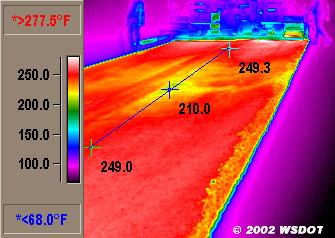Segregation and Temperature Differentials
Segregation and temperature differentials are construction-related HMA pavement problems that can lead to early pavement failure.
 |
 |
| Figure 1: Aggregate segregation in a stockpile. | Figure 2: Temperature differentials as viewed through an infrared camera. |
Aggregate Segregation
Aggregate segregation is the non-uniform distribution of coarse and fine aggregate components within the HMA mixture. There are two basic types of aggregate segregation:
- Coarse segregation. Occurs when gradation is shifted to include too much coarse aggregate and not enough fine aggregate. Coarse segregation is characterized by low asphalt content, low density, high air voids, rough surface texture, and accelerated rutting and fatigue failure (Williams, Duncan and White, 1996). Typically, coarse segregation is considered the most prevalent and damaging type of segregation, thus segregation research has typically focused on coarse segregation. The term “segregation” by itself is usually taken to mean “coarse segregation.”
- Fine segregation. Occurs when gradation is shifted to include too much fine aggregate and not enough course aggregate. High asphalt content, low density, smooth surface texture, accelerated rutting, and better fatigue performance characterize fine segregation (Williams, Duncan and White, 1996).
A quantitative aggregate segregation definition is difficult. Since coarse segregation is generally accepted as most destructive, a general quantitative definition is a sample at least 10% coarser than the JMF on the No. 4 or No. 8 sieve (Brown and Brownfield, 1988; Cross and Brown, 1993; Williams, Duncan and White, 1996).
The chief detrimental effects of segregation on HMA performance are: reduced fatigue life, rutting, raveling, and moisture damage. These effects can cause a severe reduction in pavement life. More information on segregation causes and cures can be found in Segregation Causes and Cures for Hot Mix Asphalt (QIP-110) by AASHTO and NAPA.
Construction-Related Temperature Differentials
Construction-related temperature differentials are large mat temperature differences resulting from placement of a significantly cooler portion of HMA mass into the mat. This cooler mass comes from the surface layer (or crust) typically developed during HMA transport from the mixing plant to the job site. These cooler areas will cool down to cessation temperature (the temperature at which no further compaction can take place due to increased HMA viscosity - commonly taken as 175°F) more quickly than the surrounding mat. Roller patterns developed based on general mat temperatures may not be adequate to compact these cooler areas before they cool to cessation temperature resulting in isolated spots of inadequate compaction. Thus, temperature differentials can cause isolated areas of inadequate compaction resulting in decreased strength, reduced fatigue life, accelerated aging/decreased durability, rutting, raveling, and moisture damage (Hughes, 1984; Hughes, 1989). Generally, temperature differentials greater than about 25°F can potentially cause compaction problems (Willoughby et al., 2001).
Aggregate segregation and construction-related temperature differentials display the same symptoms and result in the same types of damage, which can cause them to be confused with one another. However, the ultimate damage mechanism, excessive air voids (often expressed as "inadequate density"), is the same in both cases.


